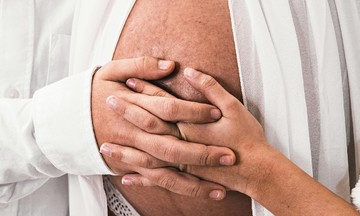Dr. Huynh Ba Tan, from the Department of Breast and Head and Neck Surgery at Tam Anh General Hospital in Ho Chi Minh City, reported that Nhung experienced grade three breast ptosis, along with excess and stretched abdominal skin marked by numerous horizontal and vertical wrinkles. Breast ptosis occurs when the nipple position shifts downwards and inwards from its normal location due to a lack of supporting muscle.
This condition often arises from weight gain during pregnancy, which stretches the skin around the breasts and abdomen. After childbirth and the cessation of breastfeeding, the abdomen shrinks and breasts decrease in size, leaving behind excess, less elastic skin. The physical act of breastfeeding and expressing milk, combined with hormonal changes, contributes to breast sagging. These two conditions can occur simultaneously in postpartum women.
Dr. Tan recommended a combined surgery to address Nhung's breast ptosis and excess abdominal skin. This involved lifting the sagging breasts and removing excess skin to create a more toned abdomen. Prior to the procedure, she underwent breast cancer screening with normal results.
The surgical team removed 25 cm of excess skin and fat, tightened the abdominal muscles, and stretched the remaining skin to reshape the abdominal area. Dr. Tan separated the breast tissue from the surrounding skin, sutured the breast tissue into folds, removed excess skin, inserted breast implants, and reshaped the breasts. During the surgery, no breast tissue was removed to avoid reducing breast volume and minimize scarring. The areola and nipple were preserved, ensuring an aesthetically pleasing outcome.
Nhung recovered well and was discharged two days after the surgery.
 |
The Breast and Head and Neck Surgery team performs the operation. Photo: Minh Tam |
The Breast and Head and Neck Surgery team performs the operation. Photo: Minh Tam
Breast ptosis has three grades, each with different treatment options, including endoscopic breast lift, mastopexy, and breast lift combined with areola reduction. Dr. Tan noted that postpartum breast ptosis is not a risk factor for breast cancer, but it can cause emotional distress, self-consciousness, and intimacy issues. This surgery should be performed in a well-equipped general hospital by a qualified surgeon. Women with cardiovascular diseases, or those who are pregnant or menstruating, should not undergo breast lift surgery.
After surgery, patients need to follow proper hygiene practices, maintain a nutritious diet, and engage in suitable physical activity to promote wound healing and prevent unsightly scarring.
Minh Tam
*The patient's name has been changed.
| Readers can submit questions about cancer here for doctors to answer. |












